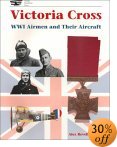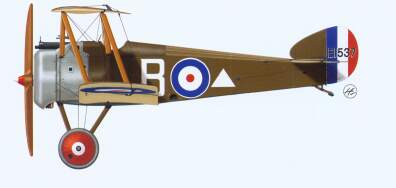Sopwith Camel
Successful and Versatile British Fighter of WWI
By Stephen Sherman, Aug. 2001. Updated April 16, 2012.
It had wicked torque and killed a lot of novice British pilots, but the Sopwith Camel (5,490 produced) shot down more German aircraft (1,294) than any other Allied plane.
Its name derived from the slight hump forward of the cockpit. Its twin 30 caliber Vickers machine guns enabled it to destroy its (by WW2 or modern standards) flimsy opponents.
Development
The Camel grew out of the Sopwith Pup, a little fighter introduced in 1916, but which was soon outclassed by the German Albatroses and Halberstadts. Sopwith's chief designer, Herbert Smith, began work on the Pup's successor in late 1916, and by December, the prototype "F.1" was ready to fly. Sopwith built several prototypes:
- F.1 - powered by 110-hp (82-kW) Clerget 9Z rotary engine, first flown by Harry Hawker at Brooklands
- F.1/1 - tapered wings and broad interplane struts
- F.1/2 - uncertain
- F.1/3 - powered by 130-hp (97-kW) Clerget 9B, test-flown at Martlesham Heath in March, 1917
- N517 - ordered by the Admiralty
- N518 - powered by new AR.1 150hp (112kW) rotary. In production, this engine became the BR.1 (Bentley Rotary) and powered the Camels delivered to the Navy.
In appearance and design, the plane was not revolutionary. A biplane combining a distinct dihedral in the lower wing with a flat upper wing, it did have a distinctive "tapered gap." The fuselage was a wooden, box-like structure, covered with aluminum up front, plywood-covered around the cockpit, and then fabric-covered back to the tail.
With its center of gravity very far forward (the engine, fuel tank, guns, and pilot were all in the front third of the plane), the aircraft was tricky to fly, but very maneuverable for a skilled pilot. While 413 Camel pilots were shot down in combat, 385 were lost in non-combat related situations, many due to the Camel's difficult handling
Specifications of the F.1 Camel:
- Engine: 130hp Clerget 9-cylinder rotary engine
- Max. Speed: 117 MPH at sea level
- Ceiling: 19,000 feet
- Climb Rate: 10 minutes to reach 10,000 feet
- Weight: 929 lb. empty, 1,453 lb. fully loaded
- Wingspan: 28 feet
- Length: 18 ft 9 in
- Height: 8 ft 6 in
- Wing area: 231 sq ft
- Guns: Two synchronized .303 inch Vickers machine guns. The Camel was the first British fighter to mount twin forward-firing machine guns side-by-side, a natural arrangement that became standard for the RAF.
- Bombs: Four 20-lb. Cooper bombs
Firms that Produced the Sopwith Camel
- Sopwith Aviation Company,
- Ruston Proctor Co. (a tractor manufacturer that built over 1,000 Camels),
- Portholme Aerodrome Ltd. (a short-lived company, located in Huntingdon, site of Portholme - the largest meadow in England, site of many airshows in the early days of aviation),
- Boulton & Paul Ltd. (a maker of prefabricated wooden buildings, including the huts for Scott's Antarctic expedition),
- British Caudron Co. Ltd.,
- Clayton & Shuttleworth Ltd. (known for steam rollers and traction engines),
- Hooper & Co. Ltd.,
- March, Jones & Cribb Ltd.,
- Nieuport & General Aircraft Ltd.,
- Wm Beardmore & Co. Ltd. (a naval shipbuilder of Dalmuir, Glasgow),
- Fairey Aviation Co. Ltd., and
- Pegler & Co. Ltd..
Camel Units
No. 3, 4, 6, 8, and 9 Naval Squadrons were among the first to receive Camels. On July 4, 1917, Camels of No. 4 Squadron attacked a flight of German Gotha bombers over Ostend, destroying at least one - the Sopwith Camel's first aerial victories.
That same month, No. 70 Squadron of the RFC also received Camels, soon followed by No. 45 and No. 43 Squadrons.
| Camel Squadrons - Autumn 1918 | |||
|---|---|---|---|
| Squadron No. | Front | Airfield | Comments |
| 3 | France | Lechelle | - |
| 46 | France | Busigny | - |
| 54 | France | Merchin | - |
| 65 | France | Bissegham | - |
| 70 | France | Droglandt | - |
| 73 | France | Malencourt | - |
| 80 | France | Bertry | - |
| 151 | France | Bancourt | - |
| 152 | France | Carvin | - |
| 201 | France | La Targette | former No. 1 Naval |
| 203 | France | Bruille | former No. 3 Naval |
| 204 | France | Heule | former No. 4 Naval |
| 209 | France | Bruille | former No. 9 Naval, Roy Brown |
| 210 | France | Boussieres | former No. 10 Naval |
| 213 | France | Bergues | former No. 13 Naval, Ray Collishaw |
| 43 - IAF | France | Bettancourt | - |
| 28 | Italy | Treviso | - |
| 66 | Italy | San Pietro | Billy Barker |
| 150 | Greece | Salonica | - |
| 222 | Greece | Thasos | - |
| 44 | England | Hainault Farm | - |
| 50 | England | Bekesbourne | - |
| 51 | England | Marham | - |
| 78 | England | Sutton's Farm | - |
| 112 | England | Throwley | - |
| 143 | England | Detling | - |
 |
The RNAS pioneered Sop Camels with their early aircraft carriers HMS Furious and Pegasus. Camels from Furious, in July 1918, bombed and destroyed the Zeppelin sheds at Tondern.
The versatile little planes were used as balloon busters and fighters. When equipped with LePrieur rockets, they were deadly against all airships. At sea, they were deployed from cruisers, battleships and even towed platforms. With Cooper bombs, they were useful as light bombers, and were also used extensively against German infantry in the trenches.
Two U.S. Air Service squadrons, the 17th and 148th, used the Camel in combat while assigned to British forces during the summer and fall of 1918. Such famous U.S. pilots as George Vaughn, Elliot White Springs, Errol Zistel and Larry Callahan were members of the 17th and 148th.
Famous Aces
Among the high-scoring aces to fly the Camel were the Canadian aces: Billy Barker, Ray Collishaw, Roy Brown (who shot down the Red Baron), Donald MacLaren.
Postwar Service
Relatively few Camels served after the Armistice; some flew for Belgium, Greece, and Poland. Camels also flew with "White" British units in the Russian Civil War.
Very few Sopwith Camels have survived into the Third Millenium. One source indicated that there are only seven originals left (not counting replicas).
Sources:
- Years of the Sky Kings, by Arch Whitehouse, Doubleday, 1964
- The Aerodrome
- Pilots and Planes of the First Air War

